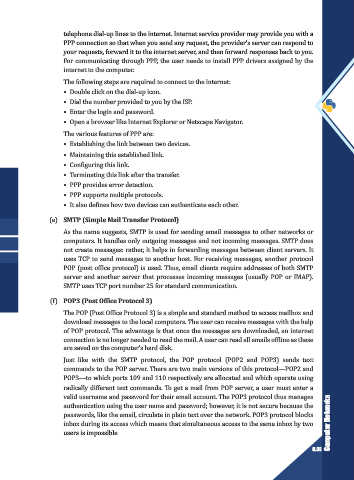Page 187 - PYTHON-12
P. 187
telephone dial-up lines to the internet. Internet service provider may provide you with a
PPP connection so that when you send any request, the provider’s server can respond to
your requests, forward it to the internet server, and then forward responses back to you.
For communicating through PPP, the user needs to install PPP drivers assigned by the
internet to the computer.
The following steps are required to connect to the internet:
• Double click on the dial-up icon.
• Dial the number provided to you by the ISP.
• Enter the login and password.
• Open a browser like Internet Explorer or Netscape Navigator.
The various features of PPP are:
• Establishing the link between two devices.
• Maintaining this established link.
• Configuring this link.
• Terminating this link after the transfer.
• PPP provides error detection.
• PPP supports multiple protocols.
• It also defines how two devices can authenticate each other.
(e) SMTP (Simple Mail Transfer Protocol)
As the name suggests, SMTP is used for sending email messages to other networks or
computers. It handles only outgoing messages and not incoming messages. SMTP does
not create messages: rather, it helps in forwarding messages between client servers. It
uses TCP to send messages to another host. For receiving messages, another protocol
POP (post office protocol) is used. Thus, email clients require addresses of both SMTP
server and another server that processes incoming messages (usually POP or IMAP).
SMTP uses TCP port number 25 for standard communication.
(f) POP3 (Post Office Protocol 3)
The POP (Post Office Protocol 3) is a simple and standard method to access mailbox and
download messages to the local computers. The user can receive messages with the help
of POP protocol. The advantage is that once the messages are downloaded, an internet
connection is no longer needed to read the mail. A user can read all emails offline as these
are saved on the computer’s hard disk.
Just like with the SMTP protocol, the POP protocol (POP2 and POP3) sends text
commands to the POP server. There are two main versions of this protocol—POP2 and
POP3—to which ports 109 and 110 respectively are allocated and which operate using
radically different text commands. To get a mail from POP server, a user must enter a
Computer Networks
valid username and password for their email account. The POP3 protocol thus manages
authentication using the user name and password; however, it is not secure because the
passwords, like the email, circulate in plain text over the network. POP3 protocol blocks
inbox during its access which means that simultaneous access to the same inbox by two
users is impossible
8.33

